Do you want to improve the strength and definition of your shoulders? Look no further than deltoid exercises.
The deltoids (commonly known as “delts”) play a crucial role in shoulder strength and mobility.
Whether you are a beginner or an advanced, delt exercises will help you get a well-rounded and balanced body.
In this blog, we will discuss everything you need to know about:
- What are deltoid muscles?
- Best delt exercises to build mass and strength
- How to build bigger delts
- Sample workout routine.

- Know About Deltoid Muscles
- Best Types of Delt Exercises To Build Mass and Strength
- 1. Compound Exercises
- 2. Isolation Exercises
- 15 Best Deltoid Exercises For Strengthening Your Shoulder
- 1. Arnold Press
- 2. Dumbbell Lateral Raise
- 3. Dumbbell Upright Row
- 4. Dumbbell Rear Delt Row
- 5. Seated Barbell Overhead Press
- 6. Clean and press
- 7. Landmine Press
- 8. Face Pull
- 9. One-Arm Bent Over Cable Raise
- 10. Cable Twisting Overhead Press
- 11. Decline Push-Up
- 12. Pike Push Up
- 13. Handstand Push Up
- 14. Resistance Band Shoulder Press
- 15. Resistance Bands Standing Reverse Fly
- Delt Workout Routine and Training Volume
- Train Your Delt As Per Your Goal
- Deltoid Workout Routine At Home
- Workout Routine For Beginner
- Delt Workout Routine For Mass
- Benefits of Strong Delts
- How To Build a Bigger Deltoid
- 1. Targeted Exercises
- 2. Proper Form
- 3. Progressive Overload
- 4. Rest and Recovery
- 5. Balanced Nutrition
- FAQs
- Can You Build Delt Without Weights?
- Do Planks Work Delt?
- Do Pushups Work Delt?
- Takeaways
Know About Deltoid Muscles
In fitness, “shoulder exercises” refer to resistance exercises that target the deltoid muscle.
While the deltoid is technically a single muscle, anatomically speaking, it has three distinct sets of muscle fibers and muscle bellies, which are referred to as “heads.
- The anterior deltoid: located at the front of the shoulder and is responsible for flexion and medial rotation of the arm.
- Lateral deltoid: Located in the middle of the shoulder and is responsible for abduction or lifting the arm away from the body.
- Posterior deltoid: Located at the back of the shoulder and responsible for the arm’s extension and lateral rotation.
The deltoids are responsible for shoulder flexion, extension, and abduction.

Best Types of Delt Exercises To Build Mass and Strength
You can add various delt exercises to your workout routine. These exercises can be broadly classified into two categories: compound exercises and isolation exercises.
1. Compound Exercises
Compound exercises work multiple muscle groups simultaneously, making them an efficient way to build overall strength and muscle mass.
Here are some examples of compound delt exercises:
- Shoulder press: Targets the entire shoulder girdle and involves lifting a barbell or dumbbell above your head.
- Push-ups: This classic exercise works the chest, triceps, and shoulders simultaneously. Variations like pike push-ups and decline push-ups put more emphasis on the shoulders.
- Clean and press: This exercise combines a power clean (lifting a weight from the floor to shoulder level) with a shoulder press.
2. Isolation Exercises
As the name implies, isolation exercises focus specifically on the deltoid muscles.
These exercises can help you achieve more targeted and defined shoulders.
Here are some examples of isolation delt exercises:
- Lateral raises: Targets the middle deltoids and involves lifting weight to the sides.
- Front raises: Targets the front deltoids and involves lifting dumbbells in front of you.
- Rear delt flyes: Targets the rear deltoids and involves lifting weight behind you.
15 Best Deltoid Exercises For Strengthening Your Shoulder
Now, let’s get into the best delt exercises for strengthening your shoulder using various types of fitness equipment and some bodyweight exercises you can do at home.
We have divided the delt exercises into several sections, such as:
- Delt exercises with dumbbells.
- Barbell delt exercises
- Deltoid exercises with cables.
- Bodyweight delt exercises at home (No Equipments).
- Exercises with a resistance band.
1. Arnold Press
The Arnold dumbbell press is an excellent exercise for building delt muscles.
It gives a wide range of motion as you lower the dumbbells well down in front, giving that maximum stretch other shoulder exercises lack.
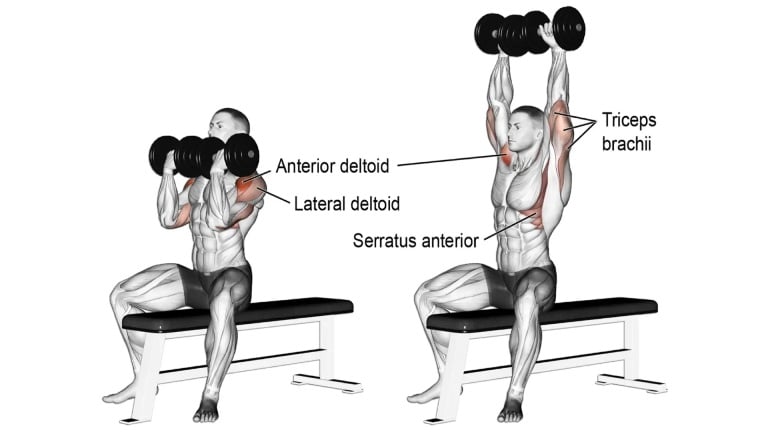
How To Do It
- Stand up straight and hold a dumbbell in each hand.
- Raise the dumbbells to the shoulder position with palms facing you.
- Now press the dumbbells overhead just like dumbbell presses, but twist them so that palms face forward at the top of the movement.
- Now lower the dumbbells in a reverse movement.
- Repeat the desired number of reps.
Tips
- Inhale when you lower the weight and exhale when you lift.
- Try to maintain a controlled motion and avoid jerky movements.
2. Dumbbell Lateral Raise
The lateral raise is an isolation exercise that primarily targets the middle delt. You may need to use lighter weights with isolation exercises.
As a lighter weight is used, more reps can be used — anything from 10 to 15 reps.
Try for more variations:
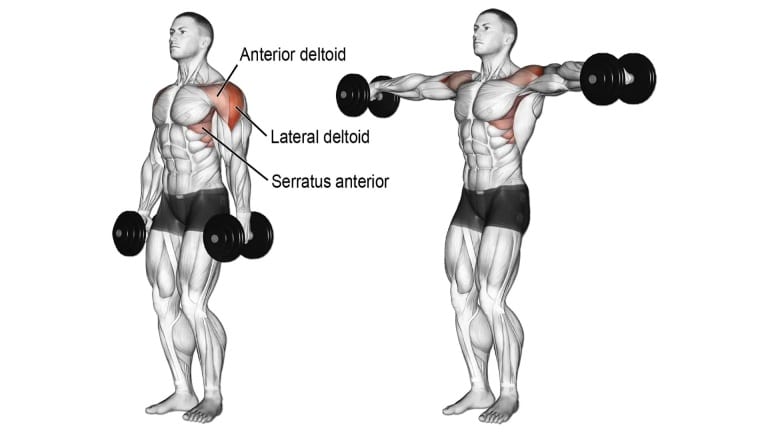
How To Do It
- Hold one dumbbell in each hand and place it to your side. The palms should be facing each other.
- Now bend your elbows and raise the dumbbells to your sides.
- Lift them to a point slightly higher than your shoulders.
- Hold at the top for a second.
- Now lower the dumbbells in a controlled manner back to the starting position.
Tips
- Don’t just swing your arms.
- Keep controlled motion throughout the exercise.
3. Dumbbell Upright Row
The dumbbell upright row is an isolation exercise that primarily targets the lateral head of the deltoids, as well as the upper trapezius muscles.
Research shows that the upright row is one of the best exercises for building delt strength and stability.
Other variations for upright rows to build the delts:

How To Do It
- Hold a dumbbell in each hand with an overhand grip, palms facing your thighs.
- Stand up straight with your arms fully extended in front of you, keeping your elbows slightly bent.
- Pull the dumbbells up towards your chest by raising your elbows up and out to the sides, keeping them higher than your forearms.
- Hold this position for a second and return slowly to the starting position
Tips
- Remember to exhale while you exert.
- Keep your core engaged and your back straight throughout the movement.
Read More: How To Do Upright Row, The Muscle Worked, Proper Form, Benefits and Its Variations
4. Dumbbell Rear Delt Row
The rear delt row exercise is simple and effective, that is used to target your lats and rear deltoids.
This exercise is very similar to a basic one-arm dumbbell row for the lats, except with a couple of important modifications.
Rear delt rows can also be done with both hands as well.
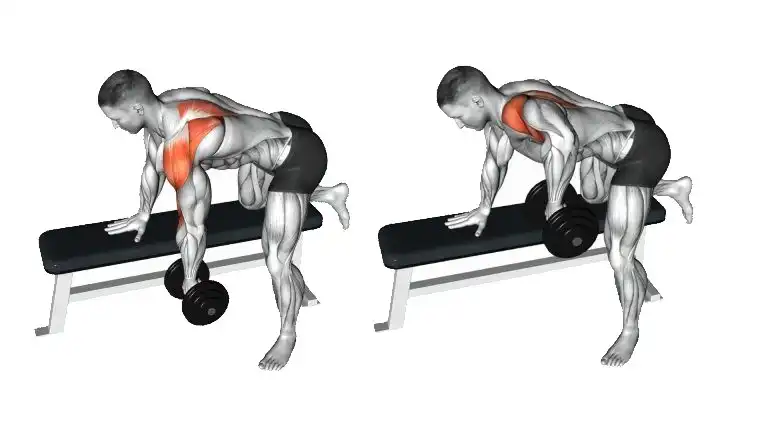
How To Do It
- Place your right foot on the floor with your left knee resting on a bench.
- Make sure that your body weight is supported by your right arm.
- While keeping your back flat, pick up a dumbbell in your right hand.
- Begin by leading up with your elbow, bringing your arm up close to your chest, and squeezing with your rear delt muscles.
- Immediately after you reach the top of the exercise, stop and hold for a count, then return to your starting position.
- Switch sides and repeat.
Tips
- Keep a controlled motion and avoid jerky movements.
- Always use weights that you can comfortably handle.
Know More: Best Dumbbell Shoulder Exercises & Workouts For Mass
5. Seated Barbell Overhead Press
If you want to add barbell exercises to your delt workout routine, the overhead press is a great staple exercise to get you started.
The shoulder press is the grand-daddy of all delt exercises for building big, round shoulder muscles.
It has been a favorite delt exercise for bodybuilders because it builds muscle quickly.

How To Do It
- Sit on an exercise bench and grab a bar with an overhand grip.
- Bring the bar over and in front of your head, under your chin, and just above your upper chest.
- Now Press the bar straight up overhead until your arms are fully extended but not locked out.
- Slowly lower the bar back to the starting position.
- Repeat the desired number of reps.
Tips
- Perform a warm-up with 50% weight for 1–2 sets.
- Keep your upper arms turned inward to keep your elbows from going out at your sides.
6. Clean and press
The clean and press is a compound exercise that targets multiple muscle groups, including the deltoids, upper back, legs, and core.
It combines two movements – the clean and the press – and is often used in weightlifting and powerlifting competitions.
The clean and press is an advanced delt exercise that requires proper technique and strength.
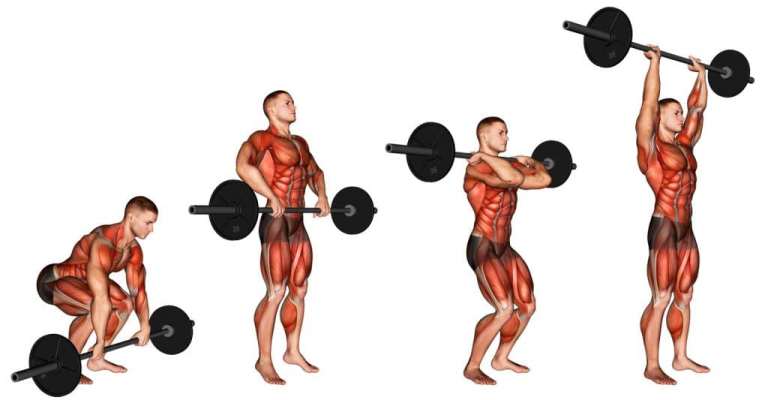
How To Do It
- Start with your feet shoulder-width apart and the barbell on the ground in front of you.
- Bend down and grasp the bar with an overhand grip.
- Lift the barbell off the ground by extending your legs and hips.
- As the bar reaches hip level, pull it up towards your chest, bending your elbows and flipping your wrists to catch the bar in front of your shoulders in the racked position.
- Stand up tall with the barbell racked on your shoulders.
- Press the barbell overhead, extending your arms fully.
- Lower the barbell back to the starting position.
- Repeat for the desired number of repetitions.
7. Landmine Press
When doing a deltoid workout with a barbell, you can add this unilateral exercise to your routine to correct potential imbalances.
The Landmine press is extremely versatile and effective for building functional strength through all planes of motion and packing on some serious muscle mass.
It is not a popular exercise, yet it provides many benefits, such as progressing your upper body and improving core stability and strength.

How To Do It
- Stand holding the weighted end of the barbell with one hand.
- Clean that bar up to shoulder height and tuck your elbow into your side.
- Your feet should be level and shoulder-width apart.
- Keeping your core braced and knees soft, press the bar up and away from you, fully extending your arm at the top.
- Press the weight up with both hands until your arms are extended, then bring it back down slowly.
- With control, lower the bar back down to the starting position.
Tips
- Hold a neutral spine throughout the movement to prevent injury.
- Lean your body forward slightly and engage your core muscles to help with stabilization.
Related Posts: Barbell Shoulder Exercises To Build Mass And Strength
8. Face Pull
Face pull is a cable machine exercise that primarily targets the rear deltoid and side delt and, to a lesser degree, also targets the arm, and traps.
This exercise prevents muscular imbalance and builds overall shoulder strength.

How To Do It
- Grab the ends of the rope attachment using a neutral grip.
- Pull the rope toward your face as you spread the ends of the rope, so they end up on the sides of your ears.
- Hold this position for a second as you squeeze your shoulder blades together.
- Then, slowly return the rope to the start position and repeat for reps.
Tips
- Stand straight with your feet in a comfortable, balanced stance.
- Your upper arms should be straight out to your sides with elbows bent.
9. One-Arm Bent Over Cable Raise
You can do this exercise with one arm at a time, changing the range of motion by adjusting the starting or finishing position.
Using this unilateral version makes it possible to raise your hand higher and get a longer stretch at the bottom, thereby generating more work for the rear deltoid.
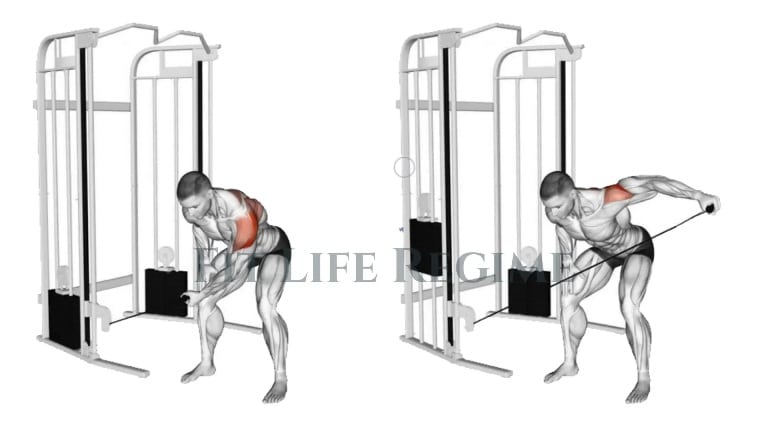
How To Do It
- Lean forward at the hips, place your right hand on your thigh
- Hold a hand in your left hand with your arm extended straight down.
- Raise the weight straight out to the side until your arm is parallel with the floor.
- Pause momentarily at the top of the motion before slowly lowering the weight back down to the starting position.
- Repeat with the right arm.
Tips
- Pull slowly so that you are in control of the weight at all times.
- Remember to exhale while you exert.
10. Cable Twisting Overhead Press
The twisting cable overhead press is an effective shoulder press variation that works the front deltoids.
It is brilliant for developing unilateral upper-body strength and improving your balance and the strength and stability of your core.
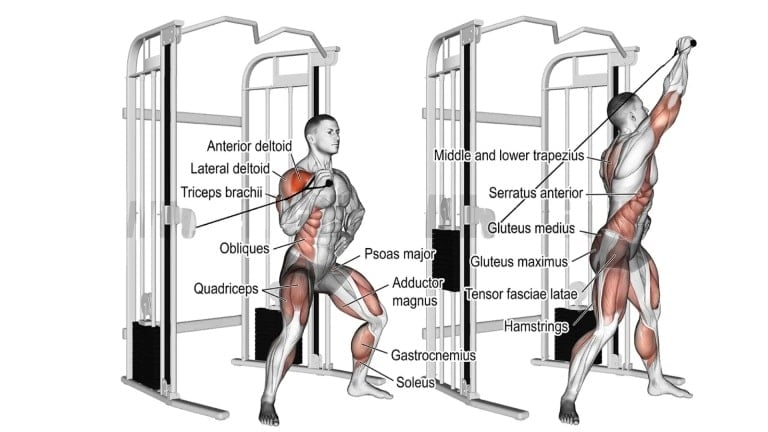
How To Do It
- Attach a stirrup (handle) to a low or waist-high pulley. Grasp the stirrup with one hand.
- Position the stirrup to the side of your body, with your elbow flexed and tucked into your side.
- Press the stirrup diagonally upward and away from the pulley.
- Hold for a count of two. Return your body and the stirrup to the starting position.
- Complete the desired number of reps with your right arm.
- Repeat the exercise with your opposite arm.
Tips
- You can place your free hand on your hip.
11. Decline Push-Up
Decline push-ups are a variation of the traditional push-up exercise that can provide an extra challenge and target different muscle groups.
In a decline push-up, your feet are elevated on a platform or bench, and your hands are placed on the ground.
This push-up variation works your upper chest and shoulders and is a great way to build up to the handstand push-up, which is the best bodyweight delt exercise.

How To Do It
- Place a bench or platform a few feet away from a wall.
- Place your feet on the bench or platform and your hands on the ground at shoulder width or slightly wider.
- Now, lift yourself off the ground, straightening your elbows and arms.
- Raise until your elbows are almost near to locked, and pause for a moment at the top of the movement.
- Now lower your body under slow, sustained motion, feeling the motion all the way down until your chest is very close to the ground.
Tips
- Keep your core engaged.
- Keep your elbows close to your body.
- Keep your body in a straight line throughout the movement.
Read More: Best Push Ups For Upper Chest To Build Size And Strength
12. Pike Push Up
If you’re looking for a straightforward bodyweight exercise to add to your delt workout routine, pike push-ups are a great staple exercise to get you started.
The Pike Push-up is a variation of the push-up that increases strength and stability in the shoulders and triceps.
Performing the exercise more upright will target the deltoid more than the chest.

How To Do It
- Start in a standard push-up position with your hands slightly wider than shoulder-width apart.
- Lift the hips up and back until your body forms an inverted V shape.
- Slowly lower the top of your head towards the ground.
- Once your head almost contacts the ground, pause for a second.
- Then, slowly push back until your arms are straight and you’re in the inverted V position.
Tips
- Make sure you maintain control throughout the movement.
- Keep arms and legs as straight as possible.
13. Handstand Push Up
The handstand push-up, also known as the vertical push-up, is one of the best push-up variations for the delt.
The handstand push-up is the king of all bodyweight delt exercises. It also strengthens your shoulder stabilization muscles and increases the strength of the upper body.
Performing this move requires a lot of balance and strength.

How To Do It
- Place hands about 6-12 inches away from the wall and slightly wider than shoulder-width apart.
- Make sure palms are facing forward, or slightly turned out 5-10 degrees.
- Kick up into a handstand, with your heels touching the wall.
- While maintaining this position, lower yourself until the top of your head touches the floor.
- Once your head touches the floor, press up with the same tightness you had, lowering yourself until your elbows reach full extension.
Tips
- Not to arch your back and keep contracting your abs.
- Point your toes, squeeze your glutes, and grip the ground with your fingertips for better stability.
Related Posts: 21 Bodyweight Shoulder Exercises: No Equipment
14. Resistance Band Shoulder Press
The resistance band shoulder press is a shoulder or overhead press variation.
It’s one of the best exercises for building size, strengthening the delt muscle, and increasing the body’s stability.
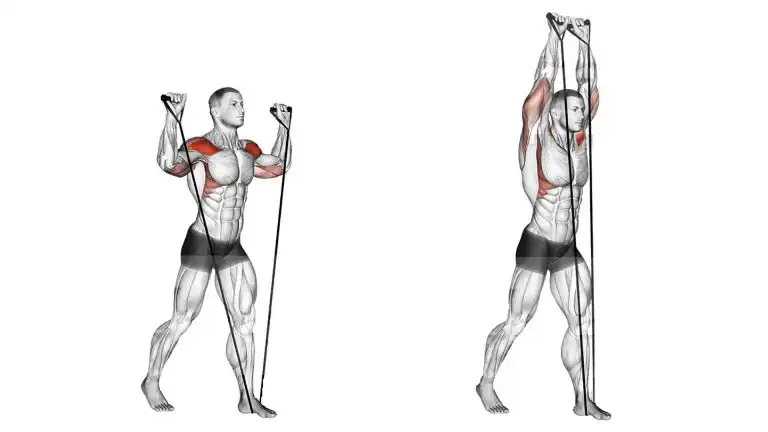
How To Do It
- Stand on your resistance band with your feet at shoulder width.
- Holding both handles, curl up your arms until your hands align with your shoulders.
- Press your arms straight overhead against the resistance of the band.
- Lower your arms until your hands are in line with your shoulders, then repeat
Tips
- Exhale during effort, and inhale during rest.
- Keep a controlled motion and avoid jerky movements
15. Resistance Bands Standing Reverse Fly
The resistance bands standing reverse fly is a compound exercise that targets the rear deltoids, upper back, rhomboids, and trapezius muscles
This is a movement that can be done on shoulder day, as it targets the rear delts.
However, we also like to hit it on a back day, as the rear delts often need to double their work each week.
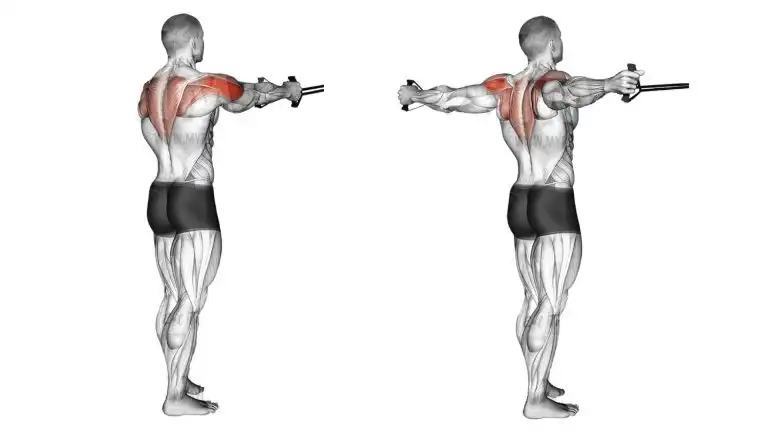
How To Do It
- Place a band around a stationary post, such as a squat rack.
- Hold the exercise band in front of you with your hands slightly lower than your shoulders.
- Open the arms out to either side, pulling the band apart.
- Return to the starting position.
- Repeat the desired number of reps.
Tips
- Keep your core engaged throughout each set.
- Try to keep your elbows up, so you can target your upper back and rear delt muscles correctly.
Delt Workout Routine and Training Volume
Of course, the number of sets and reps will be determined based on your fitness journey, but here is a great starting point:
Train Your Delt As Per Your Goal
- For muscle endurance: Aim for 3–4 sets of 12–15 reps, with moderate resistance.
- For muscle strength: Aim for 3–5 sets of 6–10 reps, with more resistance.
- For muscle hypertrophy (increased muscle size): Aim for 3–4 sets of 8–12 reps, with a moderate to heavy amount of resistance.
It is always best to start with fewer reps and sets, then gradually increase as your strength improves.
Furthermore, it is important to allow for adequate rest between sets, typically 60–90 seconds.
Deltoid Workout Routine At Home
Here’s a beginner delt exercises routine that you can do at home:
| Exercise | Sets | Reps |
|---|---|---|
| Pike Push Ups | 3-4 | 8-10 |
| Dumbbell Shoulder Press | 3-4 | 8 |
| Bent Over Lateral Raise | 4 | 8-10 |
Workout Routine For Beginner
| Exercise | Sets | Reps |
|---|---|---|
| Arnold Shoulder Press | 4 | 8-10 |
| Barbell Overhead Press | 3-4 | 6-8 |
| Face Pull | 4 | 10-12 |
| Dumbbell Upright Row | 3 | 8-10 |
Delt Workout Routine For Mass
Here’s a sample dumbbell-only shoulder workout plan for advanced individuals:
| Exercise | Sets | Reps |
|---|---|---|
| Clean And Press | 4 | 8-10 |
| Dumbbell Lateral Raise | 3-4 | 10-12 |
| Front Raise | 4 | 8-10 |
| One-Arm Bent Over Cable Raise | 3 | 10-12 |
| Barbell Upright Row | 3 | 8-10 |
When designing a workout plan, starting with a lower training volume and gradually increasing it as you build strength and endurance is important.
As you progress, you can increase the number of reps and sets and add difficulty to the exercises.
Benefits of Strong Delts
Having strong deltoids can provide several benefits, including:
- Strong deltoids can enhance overall upper body strength.
- It helps you lift heavier weights during exercises like the bench press, overhead press, and pull-ups.
- The deltoids play a crucial role in maintaining good posture by stabilizing the shoulder joint and maintaining it in proper alignment.
- Strong deltoids can improve shoulder mobility and flexibility.
- It helps you perform exercises with a wider range of motion.
- The deltoids are essential for many sports and activities, such as swimming, throwing, and grappling.
- A well-developed deltoid can provide an aesthetical look to the upper body, especially when combined with the chest, back, and arms.
- Many daily activities, such as carrying groceries and reaching for items on high shelves, rely on the deltoid. Strong deltoids can make these activities easier.
How To Build a Bigger Deltoid
Building bigger deltoids requires a combination of targeted exercises, proper form, adequate rest and recovery, and a balanced nutrition plan.
You can use these tips to build bigger deltoids:
1. Targeted Exercises
Include compound and isolation exercises targeting your deltoids, such as overhead presses, lateral raises, front raises, and reverse flyes.
Incorporating new exercises into your routine can help to target different muscle groups and prevent boredom.
2. Proper Form
You should use proper form when performing exercises to ensure that you are effectively targeting your deltoids.
3. Progressive Overload
You can challenge your muscles and stimulate growth by increasing the weight or intensity over time. You can try more advanced exercises such as handstand push-ups, clean, and press as you progress.
However, please avoid increasing the weight too quickly, as this could lead to injury.
4. Rest and Recovery
Give your muscles time to recover between workouts. Aim for 36–48 hours of rest between delt workouts.
5. Balanced Nutrition
Make sure you’re getting enough protein and calories to support muscle growth.
Maintain a balanced diet with lean protein sources, complex carbohydrates, and healthy fats.
FAQs
Can You Build Delt Without Weights?
Yes, it is possible to build delt without weights.
Bodyweight exercises such as push-ups, pike push-ups, dips, and planks can effectively target the delt and help build muscle mass and strength.
Do Planks Work Delt?
Planks are a great exercise for targeting the shoulders and the core, back, and glutes.
Planks work the shoulders by engaging the shoulder blades and the rotator cuff muscles.
By holding the plank position, the shoulders are actively working to hold the body in a stable position, which can help to build muscle and strength.
Do Pushups Work Delt?
Yes, push-ups can effectively work the delt.
Push-ups target the anterior deltoids, which are the muscles located in the front of the shoulders. They also target the triceps and chest muscles.
As you progress, you can add variation to the push-up such as incline push-ups, decline push-ups, pike push-ups and more to target the shoulders specifically.
Takeaways
Delt exercises are an effective way to build strength and muscle mass in the shoulders.
These exercises are recommended for anyone who wants to build a wider shoulder and gain strength. It is easy to do and requires no more scientific details and fancy equipment.
Add some of these exercises to your delt workout routine.
If you do these exercises consistently, the results will speak for themselves.
Thanks for reading, enjoy your workout!
Reference
- McAllister M, Schilling B, Hammond K, Weiss L, Farney T. Effect of grip width on electromyographic activity during the upright row. J Strength Cond PMID: 22362088 DOI: 10.1519/JSC.0b013e31824f23ad
- Ronai, Peter MS, CSCS, RCEP: Exercise Modifications and Strategies to Enhance Shoulder Function. Strength and Conditioning Journal: August 2005 – Volume 27 – Issue 4 – p 36-45
- Lorenzetti S, Dayer R, Pluss M, List R. Pulling exercises for strength training and rehabilitation: movements and loading conditions. J Funct Morphol Kinesiol. 2017;2(3):33. doi:10.3390/jfmk2030033

Manish brings over 10 years of hands-on experience in weight lifting and fat loss to fitness coaching. He specializes in gym-based training and has a lot of knowledge about exercise, lifting technique, biomechanics, and more.
Through “Fit Life Regime,” he generously shares the insights he’s gained over a decade in the field. His goal is to equip others with the knowledge to start their own fitness journey.
